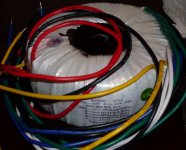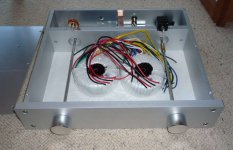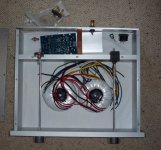As I can see,you prefer FC's before BG STD on amp's board.I have two pairs of boards,one pair with 2200uF FC's and the other with 100uF BG STD.I have to say that FC's are more transparent and neutral then BG STD.
Which max value do you recommend on PS boards?Is 100 uF BG STD to much?
Which max value do you recommend on PS boards?Is 100 uF BG STD to much?
hi,peter
i am ready to build my first 3875 amp. i got the premium kit from you last week.
i have a question about transformer i bought locally.
237VA
input 115*2
output
1)24V---4A
2)24V---4A
3)18V---1A
4)18V---1A
5)9V---1A
i just use 24V*2,4A. is it ok.
should i ues the 4A fuse?
i am ready to build my first 3875 amp. i got the premium kit from you last week.
i have a question about transformer i bought locally.
237VA
input 115*2
output
1)24V---4A
2)24V---4A
3)18V---1A
4)18V---1A
5)9V---1A
i just use 24V*2,4A. is it ok.
should i ues the 4A fuse?
Attachments
Yes, you would only need 24V windings.
4A slow blow fuse should work fine.
You really need to experiment here. I usually use 4.7/50 BG N in negative voltage section only with rectifiers board.
4A slow blow fuse should work fine.
kele1975 said:Which max value do you recommend on PS boards?Is 100 uF BG STD to much?
You really need to experiment here. I usually use 4.7/50 BG N in negative voltage section only with rectifiers board.
cabling
Hi Peter and the rest of you guys here.
Can i ask which are the "ideal" type of cables to use for connecting the external PS to the amp box? Any links or part numbers will be good also.
I have some spare silver 1mm thick wire withe teflons, jackets etc. Would this do the trick?
And i spare some speakon 4 pole connectors will those be any good for the connection?
Thank you
Nick
Hi Peter and the rest of you guys here.
Can i ask which are the "ideal" type of cables to use for connecting the external PS to the amp box? Any links or part numbers will be good also.
I have some spare silver 1mm thick wire withe teflons, jackets etc. Would this do the trick?
And i spare some speakon 4 pole connectors will those be any good for the connection?
Thank you
Nick
I found that Cardas 19.5ga hook up wire worked best for me, as for connectors I'm using 4 pin Neutriks.
any links if possible to the cardas cables you mentioned?
4-pole(pin) speakon neutriks i ment.
thank you
Nick
4-pole(pin) speakon neutriks i ment.
thank you
Nick
I never used speakon neutriks, only XLRs. You will find info on Cardas here: http://www.partsconnexion.com/t/catalog/wire_files/sheet001.html It is stranded wire with heavy enamel coating and solder pot is needed for termination.
Just posting to say thank you Daniel for the very reasonably priced kit amp boards. i completed the kit a week ago with mostly premium parts and am in the process of burning it in.
Having owned many valve amplifiers and various iterations and tweaked versions of the T amp and the Charlize in the past, i must say i am mightily impressed with the sound. Totally unlike those T-amps which could sound cold and sterile. if i was listening blind i would not for one moment have dismissed it as not being a valve amplifier of sorts.Very neutral, tonally accurate with good bass, excellent timing and rhythm and dynamically all I could ask for in a sensitive speaker set up. Although the DIY speakers are also relatively new to me i am still struggling to find a distinguishing character to the sound from the amp, and that in my book is high praise indeed. i am waiting for the parts to build the F5 next which i am very excited about.
So thank you again Daniel for that and the Shigaclone the best transport i have ever used.
Having owned many valve amplifiers and various iterations and tweaked versions of the T amp and the Charlize in the past, i must say i am mightily impressed with the sound. Totally unlike those T-amps which could sound cold and sterile. if i was listening blind i would not for one moment have dismissed it as not being a valve amplifier of sorts.Very neutral, tonally accurate with good bass, excellent timing and rhythm and dynamically all I could ask for in a sensitive speaker set up. Although the DIY speakers are also relatively new to me i am still struggling to find a distinguishing character to the sound from the amp, and that in my book is high praise indeed. i am waiting for the parts to build the F5 next which i am very excited about.
So thank you again Daniel for that and the Shigaclone the best transport i have ever used.
Hi Peter,
I have not found in this thread the suggested wiring for the grounding of your kit in the case of a monoblock.
Following your suggestion in the case of a stereo amp I made this guess:
PG+ from rectifier board to PG+ of amp board.
PG- from rectifier board to PG- of amp board.
Using the free PG+ and PG- holes of the rectifier board connect them to the chassis ground, where also the AC main inlet ground is connected.
Is this correct?
Please forgive me for my English
Renato
I have not found in this thread the suggested wiring for the grounding of your kit in the case of a monoblock.
Following your suggestion in the case of a stereo amp I made this guess:
PG+ from rectifier board to PG+ of amp board.
PG- from rectifier board to PG- of amp board.
Using the free PG+ and PG- holes of the rectifier board connect them to the chassis ground, where also the AC main inlet ground is connected.
Is this correct?
Please forgive me for my English
Renato
That is not correct way, as both PS grounds should meet at the amp pcb. In case of monoblocks, just use the CHG pad on amp board for chassis connection (CHG stands for"CHassis Ground")
Peter Daniel said:Yes, you would only need 24V windings.
4A slow blow fuse should work fine.
the chassis is DIY.
i will use 2 transformers.
it's better to lay out like this?
Attachments
Peter Daniel said:Yes, you would only need 24V windings.
4A slow blow fuse should work fine.
Attachments
Just placed my order for the premium 3875 kit this week and am getting quite excited to start building. I have been hunting for a transformer and am having a hard time. I managed to find a ready wound transformer with these specs and am wondering it it would work.
"230VA Custom Toroidal Power Transformer. 3 Outputs: 12.0V; 24.00V x 2" Can I just use the two 24V rails?
I was hoping to get a 300VA with 22v rails. But this is apparently not all that simple. Or will take several weeks

"230VA Custom Toroidal Power Transformer. 3 Outputs: 12.0V; 24.00V x 2" Can I just use the two 24V rails?
I was hoping to get a 300VA with 22v rails. But this is apparently not all that simple. Or will take several weeks

Peter Daniel said:I found that Cardas 19.5ga hook up wire worked best for me, as for connectors I'm using 4 pin Neutriks.
Peter,
Just thinking out loud here. I'm wondering if solid core Cat 5 wire would be a cost effective alternative for delivering the DC to a Gainclone. The only potential downside is it's 24 ga.
Regards,
Dan
You could try it, it might work, even it's only 24ga.
I always use 19.5ga Cardas, it worked best for me.
I always use 19.5ga Cardas, it worked best for me.
Mike-Toronto said:Just placed my order for the premium 3875 kit this week and am getting quite excited to start building. I have been hunting for a transformer and am having a hard time. I managed to find a ready wound transformer with these specs and am wondering it it would work.
"230VA Custom Toroidal Power Transformer. 3 Outputs: 12.0V; 24.00V x 2" Can I just use the two 24V rails?
I was hoping to get a 300VA with 22v rails. But this is apparently not all that simple. Or will take several weeks

Plitron lead time is approx 10 days. The problem though is their $250 minimum order.
If you use 24V rails only on the other transformer, it should work fine too.
cyxg said:the chassis is DIY.
i will use 2 transformers.
it's better to lay out like this?
The layout looks good.
Peter Daniel said:Plitron lead time is approx 10 days. The problem though is their $250 minimum order.
I ordered a single 300VA from Plitron and had no issues. Was $130 shipped, but you should be able to pick it up and save $30.
- Home
- More Vendors...
- Audio Sector
- Commercial Gainclone kit- building instructions


